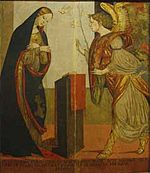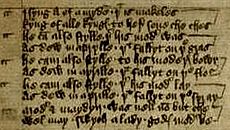I syng of a mayden facts for kids
"I syng of a mayden" (sometimes titled "As Dewe in Aprille") is a Middle English lyric poem or carol of the 15th century celebrating the Annunciation and the Virgin Birth of Jesus. It has been described as one of the most admired short vernacular English poems of the late Middle Ages.
Written by an anonymous hand, the text is now only to be found in the Sloane Manuscript 2593, a collection of medieval lyrics now held in the British Library, although contemporary sources suggest it was well known in its day. Originally intended to be sung, no evidence of the work's musical setting survives, and since its rediscovery and popularisation it has formed the basis for a number of modern choral and vocal works.
Origin
The manuscript in which the poem is found, (Sloane 2593, ff.10v-11) is held by the British Library, who date the work to c.1400 and speculate that the lyrics may have belonged to a wandering minstrel; other poems included in the manuscript include "I have a gentil cok", "Adam lay i-bowndyn" and two riddle songs – "A minstrel's begging song" and "I have a yong suster". The Chaucer scholar Joseph Glaser notes that 2593 contains the only surviving copies of several "indispensable" poems. These include the aforementioned poem "Adam lay i-bowndyn", "A Babe is born al of a may", "Benedicamus Domino" and "Lullay, myn lykyng".
In 1836, Thomas Wright suggested that, although his fellow antiquarian Joseph Ritson had dated the manuscript from the reign of Henry V of England (1387–1422), he personally felt that although "its greatest antiquity must be included within the fifteenth century", some lyrics contained within may be of an earlier origin. Wright speculated, on the basis of the dialect of Middle English, that the lyrics probably originated in Warwickshire, and suggested that a number of the songs were intended for use in mystery plays. More recent analysis of the manuscript places the dialect as being of East Anglian original and more specifically Norfolk; two further carol MSS from the county contain duplicates from Sloane 2593. However, "I syng of a mayden" is a unique instance of this lyric.
Although the Sloane Manuscript is the only surviving textual source, the bibliographer and Shakespearean scholar W. W. Greg proposed that the poem's similarity to a much earlier 13th-century poem held at Trinity College, Cambridge (MS. B. 13. 49) was unlikely to be accidental. Alan J. Fletcher, a specialist in Latin liturgical drama and the late Middle Ages, noted in 1978 that a set of contemporary sermons compiled by a writer called Selk (Bodleian MS Barlow 24) quote the final phrases of the poem in such a way to suggest the poem was more widely disseminated and known in its time:
- Mayde, Wyff and Moder whas neure but ye
- Wel may swych a ladye Goddys modyr be.
Musical setting
As most explicitly noted by the first quatrain, the poem was originally intended to be sung. Indeed, as noted by Stephen Medcalf, Emeritus Reader in English at the University of Sussex, the text itself seems to imply melody and verse. However, due to the oral tradition of the time, the original melody of the song was not notated and over the course of time was forgotten.
Since the rediscovery of the text, many composers have set the text to music, amongst them diverse choral or vocal interpretations by Martin Shaw, Patrick Hadley, Roger Quilter, John Gerrish, Gustav Holst, Arnold Bax Peter Warlock, R.R. Terry, Lennox Berkeley, Benjamin Britten ("As Dewe in Aprille" in his Ceremony of Carols), Ronald Corp (1975), Philip Lawson a setting published by Walton Music, John Adams (as the chorus "I Sing of a Maiden" in his opera-oratorio El Niño), and Bob Chilcott (in his "Salisbury Vespers"). The work is also regularly performed by the Mediaeval Baebes. The setting composed by Miklós Rózsa is also included in the 1953 Knights of the Round Table film score.



